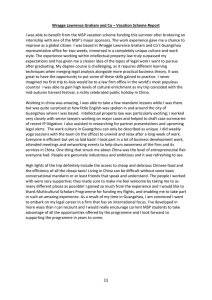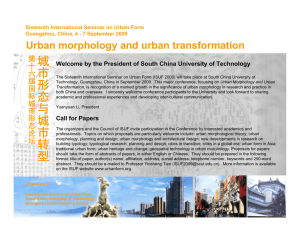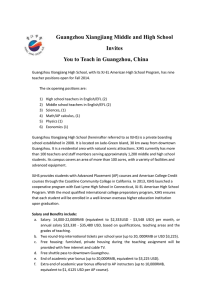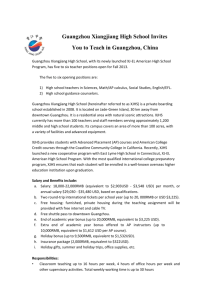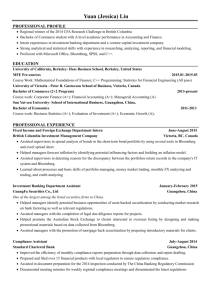Document 13724637
advertisement
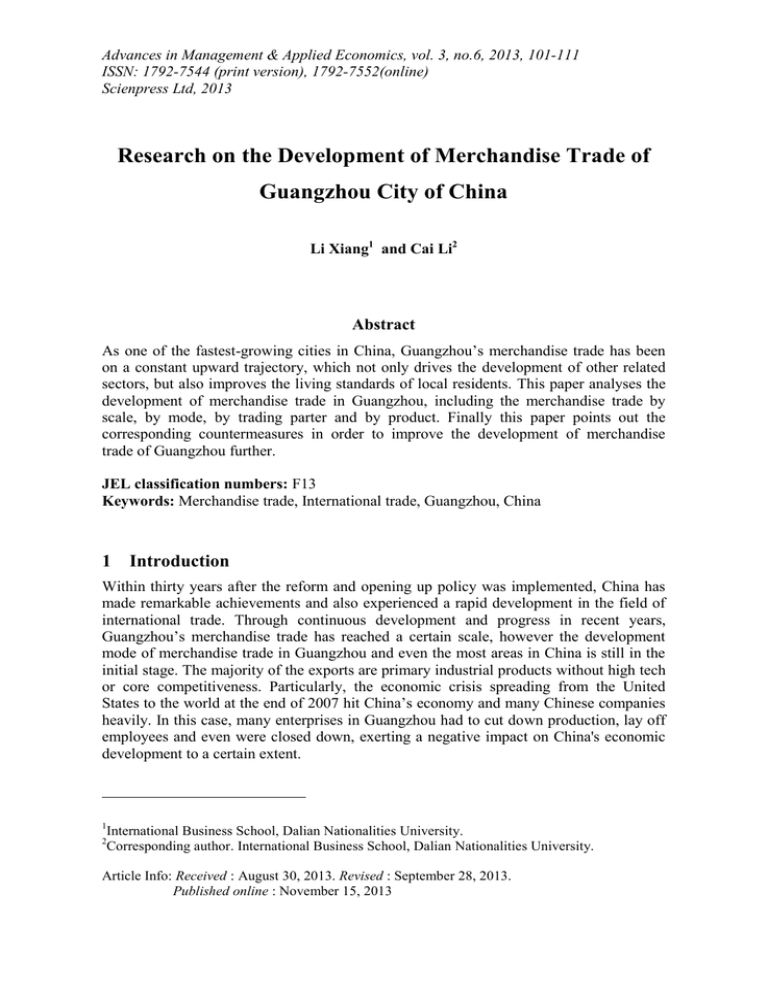
Advances in Management & Applied Economics, vol. 3, no.6, 2013, 101-111 ISSN: 1792-7544 (print version), 1792-7552(online) Scienpress Ltd, 2013 Research on the Development of Merchandise Trade of Guangzhou City of China Li Xiang1 and Cai Li2 Abstract As one of the fastest-growing cities in China, Guangzhou’s merchandise trade has been on a constant upward trajectory, which not only drives the development of other related sectors, but also improves the living standards of local residents. This paper analyses the development of merchandise trade in Guangzhou, including the merchandise trade by scale, by mode, by trading parter and by product. Finally this paper points out the corresponding countermeasures in order to improve the development of merchandise trade of Guangzhou further. JEL classification numbers: F13 Keywords: Merchandise trade, International trade, Guangzhou, China 1 Introduction Within thirty years after the reform and opening up policy was implemented, China has made remarkable achievements and also experienced a rapid development in the field of international trade. Through continuous development and progress in recent years, Guangzhou’s merchandise trade has reached a certain scale, however the development mode of merchandise trade in Guangzhou and even the most areas in China is still in the initial stage. The majority of the exports are primary industrial products without high tech or core competitiveness. Particularly, the economic crisis spreading from the United States to the world at the end of 2007 hit China’s economy and many Chinese companies heavily. In this case, many enterprises in Guangzhou had to cut down production, lay off employees and even were closed down, exerting a negative impact on China's economic development to a certain extent. 1 2 International Business School, Dalian Nationalities University. Corresponding author. International Business School, Dalian Nationalities University. Article Info: Received : August 30, 2013. Revised : September 28, 2013. Published online : November 15, 2013 102 Li Xiang and Cai Li Therefore, this paper points out countermeasures based on the in-depth analysis on Guangzhou’s merchandise trade in order to withstand risks and stabilize the economy development. 2 The Situation of Merchandise Trade of Guangzhou City of China 2.1 Merchandise Trade by Scale In import, the total import value of Guangzhou kept on increasing from 1987 (USD1.147 billion) to 1994 (USD7.467 billion), then fluctuated from 1994 to 1998, and showed an upward trend from 1998 to 2011; especially in recent years, it has grown sharply. Guangzhou’s total import value accounted for an unstable proportion of the total import value of Guangdong Province. The most obvious ascent was that the proportion rose from 10.49% in 1992 to the peak 17.05% in 1993. Guangzhou contributed more and more to China's total import value from 1987 to 1993, however the contribution fluctuated from 1993 to 2011 with an apparent decline trend. As for export, the total export value of Guangzhou tended to climb from 1987 to 1995, however fluctuated from 1995 to 2000 (in 2009, it declined due to the financial crisis), and then grew from 2000 to 2011. The proportion of Guangzhou’s export value in Guangdong’s export value dropped down from 1987 to 1989, and then hit up to 17.25% in 1993 and 17.27% in 1994. Although there were some signs of recovery from 1994 to 2011, it represented an overall downward trend. From 1987 to 1994, Guangzhou’s export value contributed an increasing proportion to China's total export value; from 1994 to 2011, the contribution tended to fall except for some little recovery in some years. Within several years beginning from 1987, Guangzhou’s merchandise trade surged. Then, after a steady development, Guangzhou’s merchandise trade showed a rising trend again with the economic expansion, although it ever suffered slight downturn due to the global financial crisis. Table 1: Merchandise Trade of Guangzhou City of China by Scale, 1987-2011. (USD 100 million) Year Import Value Share of Guangdong Province's Import Value (%) Share of China’s Import Value (%) 1987 1988 1989 1990 1991 1992 1993 1994 1995 1996 1997 11.47 17.66 17.62 18.24 24.40 33.88 69.84 74.67 71.32 75.53 81.51 10.53 10.90 10.09 9.27 9.59 10.49 17.05 16.07 15.05 14.92 14.67 2.65 3.20 2.98 3.42 3.83 4.20 6.72 6.46 5.40 5.44 5.73 Annual Growth Rate of Import Value (%) ----53.97 -0.23 3.52 33.77 38.85 106.14 6.92 -4.49 5.90 7.91 Export Value Share of Guangdong Province's Export Value (%) Share of China’s Export Value (%) 10.24 14.59 17.70 23.55 29.42 36.87 64.49 86.69 95.67 91.36 105.95 10.10 9.85 9.77 10.60 10.87 11.02 17.25 17.27 16.91 15.39 14.21 2.60 3.07 3.37 3.79 4.09 4.34 7.03 7.16 6.43 6.05 5.80 Annual Growth Rate of Export Value (%) ----42.48 21.32 33.05 24.93 25.32 74.91 34.42 10.36 -4.59 15.97 Research on the Development of Merchandise Trade of Guangzhou City of China 1998 1999 2000 2001 2002 2003 2004 2005 2006 2007 2008 2009 2010 2011 75.39 93.18 115.60 114.13 141.49 180.52 233.14 268.07 313.85 355.91 389.47 392.82 553.89 596.98 13.91 14.87 14.79 14.09 13.79 13.81 14.08 14.12 13.93 13.44 13.94 15.59 16.70 15.65 5.38 5.62 5.14 4.69 4.79 4.37 4.15 4.06 3.97 3.72 3.44 3.91 3.97 3.42 7.50 23.60 24.06 1.27 23.97 27.58 29.15 14.98 17.08 13.40 9.43 0.86 41.00 7.78 103.08 98.67 117.91 116.24 137.78 168.89 214.74 266.68 323.77 379.03 429.26 374.03 483.79 564.73 13.63 12.70 12.83 12.18 11.63 11.05 11.21 11.20 10.73 10.23 10.62 10.42 10.68 10.62 5.61 5.06 4.79 4.37 4.23 3.85 3.62 3.50 3.34 3.11 3.00 3.11 3.07 2.97 103 -2.71 -4.28 19.50 -1.42 18.53 22.58 27.15 24.19 21.41 17.07 13.25 -12.87 29.35 16.73 Source: Guangzhou Provincial Bureau of Statistics, China National Bureau of Statistics Survey Office in Guangzhou, Guangzhou Statistical Yearbook, China Statistics Press (Beijing, 2012), Statistics Bureau of Guangdong Province, Guangdong Survey Office of China National Bureau of Statistics, Guangdong Statistical Yearbook, China Statistics Press (Beijing, 2012) 2.2 Merchandise Trade by Mode The trade modes of Guangzhou have not changed significantly in recent years. As Table 2 shows, there are two main trade modes in Guangzhou, namely general trade and processing trade (processing trade can be further divided into processing with imported materials and processing with provided materials). General trade and processing trade contributed nearly 90% to the total value of merchandise trade of Guangzhou. Therefore, the development of general trade and processing trade affects and even determines the development of Guangzhou’s merchandise trade to a large extent. In 2011, the export value of general trade and processing trade was higher than the import value respectively. Specifically, the import value of general trade reached USD31.6 billion, accounting for 52.93% of Guangzhou’s total import value. The export value of general trade amounted to USD24.69 billion, accounting for 43.72% of Guangzhou’s total export. Meanwhile, processing trade generated the export value of USD28.93 billion, accounting for 51.2% of Guangzhou’s export; wherein, processing with imported materials created the export value of USD22.02 billion, and processing with provided materials brought USD6.91 billion. The import value of processing trade equaled to USD21.82 billion, accounting for 36.54% of Guangzhou’s import. It consisted of USD16.89 billion from processing with imported materials and USD4.93 billion from processing with provided materials. 104 Li Xiang and Cai Li Table 2: Merchandise Trade of Guangzhou City of China by Mode, 2011. (USD10,000) Mode Export Share Import Share Value (%) Value (%) General Trade 2469250 43.72 3160031 52.93 Processing Processing with 690811 12.23 493110 22.60 Trade Provided Materials Processing with 2202185 39.00 1688542 13.94 Imported Materials Total 2892996 51.23 2181652 36.54 Other Modes 285092 5.05 628151 10.53 Total 5647338 100 5969834 100 Source: Wang Linsheng, Guangzhou Yearbook, Guangzhou Yearbook Press, 2012 2.3 Merchandise Trade by Partner The export of Guangzhou to major trading partners continued to grow in 2011, especially the export to Latin America and other emerging markets performed better than the average level. By the value of merchandise, Guangzhou’s top five trading partners in 2011 were the United States, Japan, Hong Kong, South Korea and the Separate Customs Territory of Taiwan, Penghu, Kinmen and Matsu. The value of the merchandise transacted among them was equivalent to 48% of the total value of the transacted merchandise of Guangzhou. Table 3 shows us top 20 countries or regions which transacted with Guangzhou. The data of these countries or regions can explain clearly their influence on the development of merchandise trade of Guangzhou. In terms of export, Hong Kong and the United States ranked top two, the value of the merchandise imported by them accounted for 23.77% and 17.72% of the export of Guangzhou respectively. Following Hong Kong and the United States, Japan and Germany ranked third and fourth with the respective share of 5.16% and 3.72%. Therefore, for Guangzhou, Hong Kong, the United States and Japan were three main export destinations. For the sake of speeding up the development of merchandise trade of Guangzhou, the trade scope between Guangzhou and these countries or regions should be broadened. As for import, Japan, South Korea and the United States were major importing partners of Guangzhou, they acquired 19.37%, 12.33% and 7.70% of Guangzhou’s total import separately. The trade relations and cooperation among these countries should be enhanced. By proportion, these twenty countries or regions played key roles in Guangzhou’s merchandise trade, sharing 74.88% of Guangzhou’s export and 85.74% of Guangzhou’s import. Some changes in the development of economy and policies of these countries will directly or indirectly affect the development of merchandise trade of Guangzhou, so Guangzhou should further intensify the communication and cooperation with them. Research on the Development of Merchandise Trade of Guangzhou City of China 105 Table 3: Merchandise Trade of Guangzhou City of China by Country or Region, 2011. (USD10,000) Export Ranking 1 2 3 4 5 6 7 8 9 10 11 12 13 14 15 16 17 18 19 20 Importing Country/ Region Hong Kong USA Japan Germany Tai Pei, Chinese South Korea Belgium United Kingdom Singapore Netherlands Mexico Vietnam Australia Malaysia Indonesia Brazil United Arab Emirates India France Thailand Total of the above Export Value Share (%) Import Ranking Import Value Share (%) 1156293.88 736202.90 459227.07 376322.72 298651.65 19.37 12.33 7.70 6.30 5.00 6 7 8 Exporting Country/ Region Japan South Korea USA Macau Tai Pei, Chinese Germany Thailand Indonesia 1342321.54 1000644.98 291671.56 210152.93 171172.27 23.77 17.72 5.16 3.72 3.03 1 2 3 4 5 115148.61 104706.03 101515.17 2.04 1.85 1.80 230969.97 210613.85 205060.78 3.87 3.53 3.43 98738.93 96364.59 95841.50 92191.47 88891.20 85619.02 84813.44 83063.60 82064.77 1.75 1.71 1.70 1.63 1.57 1.52 1.50 1.47 1.45 9 10 11 12 13 14 15 16 17 Malaysia Australia France South Africa Switzerland Chile Hong Kong India Singapore 200347.40 184287.69 183903.21 156555.72 123228.38 108479.18 91822.88 87051.75 78941.12 3.36 3.09 3.08 2.62 2.06 1.82 1.54 1.46 1.322 81823.42 81399.97 74890.01 4228980.01 1.449 1.441 1.33 74.88 18 19 20 Belgium Spain Russia Total of the above 78872.41 75915.37 75630.02 5118377.95 1.321 1.27 1.266 85.74 Source: Wang Linsheng. Guangzhou Yearbook. Guangzhou Press. 2012. 2.4 Merchandise Trade by Product Tables 4 and 5 indicate 17 categories of products with the export value of more than USD100 million and 18 categories of products with the import value of over USD100 million of Guangzhou. For export, the export value of mechanical and electrical products, audio-visual equipment, parts and accessories was the highest, accounting for 31.20% of Guangzhou’s total export value; the export value of textile materials and products accounted for 13.61%; the export value of vehicles, aircrafts, ships and transport equipment accounted for 9.32%. From the perspective of import, the import value of mechanical and electrical products, audio-visual equipment, parts and accessories hit the highest level, accounting for 21.91% of Guangzhou’s total import value; the import value of base metals and related products accounted for 13.72%; the import value of optical and medical instruments, clocks and musical instruments accounted for 11.83%. Basically, Guangzhou mainly exports labor-intensive products although high-tech products are developing fast. In this case, Guangzhou should accelerate the exploitation of its core industries and high-tech modern innovative products. Meanwhile, Guangzhou should change the situation that labor-intensive products play key roles in export, as well as reform the structure of imported products. In short, it is urgent for Guangzhou to conduct technological reform and development for changing the pattern of merchandise trade of Guangzhou. 106 Li Xiang and Cai Li Table 4: Merchandise Export of Guangzhou City of China by Product, 2011. (USD10,000) Export Ranking 1 2 3 4 5 6 7 8 9 10 11 12 13 14 15 16 17 18 Category Export Value Share (%) Mechanical and electrical products, audio-visual equipment, parts and accessories Textile materials and products 1761929.37 31.20 768865.86 13.61 Vehicles, aircrafts, vessels and transport equipment Base metals and related products Optical and medical instruments, clocks, musical instruments Miscellaneous products Jewelry, precious metals and related products, imitation jewellery, coins Plastic and plastic products, rubber and rubber products Chemical products and related products Shoes, hats, umbrellas, feather products, artificial flowers, hair products Leather, fur and related products, bags Minerals Wood pulp, waste paper, paper, cardboard and related products Mineral materials, ceramics, glass and related products Food, beverage, liquor, vinegar, tobacco and related products Wood and related products, charcoal, cork, wickerwork Live animals, animal products Plant products Total of the above 526516.59 9.32 427927.66 7.58 386019.01 6.84 358383.94 327572.06 6.35 5.80 255233.74 4.52 189365.61 3.35 154569.17 2.74 143494.74 2.54 131880.33 64602.88 2.34 1.14 57902.05 1.03 38300.74 0.68 23082.59 0.41 15842.51 0.28 12083.72 5643572.57 0.21 99.94 Source: Wang Linsheng. Guangzhou Yearbook. Guangzhou Press. 2012. Research on the Development of Merchandise Trade of Guangzhou City of China 107 Table 5: Merchandise Import of Guangzhou City of China by Product, 2011. (USD10,000) Import Ranking 1 2 3 4 5 6 7 8 9 10 11 12 13 14 15 16 17 18 19 Category Import Value Share (%) Mechanical and electrical products, audio-visual equipment, parts and accessories Base metals and related products Optical and medical instruments, clocks, musical instruments Plastic and plastic products, rubber and rubber products Minerals Vehicles, aircrafts, vessels and transport equipment Chemical products and related products Jewelry, precious metals and related products, imitation jewellery, coins Textile materials and products Plant products Special commodities and unclassified goods Food, beverage, liquor, vinegar, tobacco and related products Animal and vegetable oil, grease, wax, refined edible oil and grease Wood pulp, waste paper, paper, cardboard and related products Live animals, animal products Leather, fur and related products, bags Miscellaneous products Wood and related products, charcoal, cork, wickerwork Mineral materials, ceramics, glass and related products Total of the above 1307761.54 21.91 818863.59 705932.89 13.72 11.83 568625.04 9.52 535538.34 487647.92 8.99 8.17 473468.96 7.93 210082.23 3.52 160628.50 134303.51 112450.82 2.69 2.25 101679.23 1.70 84274.72 1.41 74103.64 1.24 54514.50 45200.27 0.91 0.76 35243.93 30774.98 0.59 0.52 23690.63 0.40 5853434.42 98.05 Source: Wang Linsheng. Guangzhou Yearbook. Guangzhou Press. 2012. 2.5 Merchandise Trade by Enterprise Table 6 represents the merchandise trade of foreign-invested enterprises and their contribution of Guangzhou's imports and exports in 2011. Foreign-funded enterprises mainly exist in three forms: equity joint venture, contractual joint venture and wholly foreign-owned enterprise. Equity joint ventures and wholly foreign-owned enterprises occupy the major positions of foreign-funded enterprises of Guangzhou. As for merchandise trade, the export value of foreign-funded enterprises amounted to USD28.515 billion, accounting for 42.90% of Guangzhou’s export value. Their import value was USD30.753 billion, sharing 51.51% of Guangzhou’s import value. In both of export and import, foreign-funded enterprises contributed nearly 50% to Guangzhou’s merchandise trade. Hence, Guangzhou should make advantage of foreign-funded 108 Li Xiang and Cai Li enterprises to boost the development of merchandise trade, accelerate the development of Sino-foreign cooperative enterprises, and make effective use of foreign capital to promote the development of the merchandise trade of local enterprises in Guangzhou. Table 6: Merchandise Trade of Guangzhou City of China by Enterprise, 2011 (USD10,000) Enterprise Equity Joint Ventures Contractual Joint Venture Wholly Foreign-owned Enterprise Total of the Above Export Value 676564 127769 Share (%) Import Value Share (%) 10.12 1.92 782301 72467 13.10 1.21 2047123 30.80 2220558 37.20 2851456 42.90 3075326 51.51 Source: Guangzhou Provincial Bureau of Statistics, China National Bureau of Statistics Survey Office in Guangzhou, Guangzhou Statistical Yearbook, China Statistics Press (Beijing, 2012) 3 Recommended Policy for Improving Merchandise Trade of Guangzhou City of China 3.1 Accelerating Transformation and Upgrading of Industrial Structure Guangzhou’s economic development can prompt the increase in merchandise trade. Therefore, the upgrading of the industrial structure has become a necessary measure to stimulate the economic development of Guangzhou. For transformation and upgrading of the industrial structure, Guangzhou should advance the balanced regional development, actively utilize the advantages in labor force and land resources, transfer the processing and assembly industry with a relatively simple administrative process, accelerate the development of technology-intensive industries and other high value-added industries, as well as ensure the rational industrial layout. Besides, Guangzhou government need make a solid planning for the construction of industrial parks, then speed up the construction and form industrial agglomeration, as well as avoid the waste of land resources and construction costs caused by idle industrial parks. Furthermore, Guangzhou should advocate the development of the productive service industry, vigorously develop the information technology industry and third-party logistics, extend the industrial chain, shorten the cycle from R & D to marketing. 3.2 Speeding up Technological Innovation Activities Accelerating technological innovation, raising production efficiency and reducing production costs are the prerequisites for Guangzhou to occupy a favorable position in the international competition. Nowadays, the international competition mainly rests in the competition in technology and talents. The development of science and technology is the core driving force for the industrial upgrading, competitiveness and economical growth of a country. Guangzhou Research on the Development of Merchandise Trade of Guangzhou City of China 109 need change the existing irrational and backward production through digesting, absorbing and using the existing or the introduced new technologies. Moreover, Guangzhou should improve the utilization efficiency of production materials and cut down production costs to push forward the development of merchandise trade. 3.3 Using Foreign Investment Reasonably It is significant for Guangzhou to attract, utilize and guide foreign investment in merchandise trade. The introduction of foreign investment can greatly ease the employment pressure in Guangzhou, facilitate the technological upgrading of enterprises, intensify the management of enterprises and stimulate economic growth of Guangzhou. In order to rationally use foreign investment and improve itself, Guangzhou should finish the following tasks. First of all, Guangzhou needs to create fair competition environments for investment in order to protect the safety and legality of foreign investment. Second, Guangzhou should provide appropriate preferential policies for the foreign investment in high-tech, scientific and technological R & D, information technology services and other fields. Third, Guangzhou should judge the impact of foreign investment on the development of Guangzhou’s merchandise trade alertly and sensibly and restrict the foreign investment which may cause serious environmental pollution. 3.4 Improving Business Operation Environments Guangzhou need learn from practice and experience at home and abroad, make in-depth research on the problems that exist in the current operating environments of Guangzhou, and propose new approaches on the improving of legal, administrative, market and social environments. Additionally, Guangzhou should limit the expansion of high-pollution, high-energy-consumption and low-efficient enterprises to control the overall environmental quality. Also, Guangzhou should encourage the merchandise trade of private enterprises and support small and medium-sized enterprises. This is because that the development of private enterprises, especially small and medium-sized enterprises, reflects the substantial progress of production technology, operation, management, product innovation and competitiveness of enterprises of Guangzhou. 3.5 Strengthening the Development of Foreign Trade For reinforcing foreign trade, on one hand, Guangzhou should make detailed and effective solutions as well as reach consensus with copartners, on the other hand, Guangzhou should inspire private enterprises to seek new multinational investment projects. This is not only beneficial for economic development, but also in favor of some enterprises in exploring investment channels and learning from foreign advanced technology and management experience. 3.6 Diversifying International Trade Modes Currently, general trade and processing trade are the most important trade modes of Guangzhou and they contribute nearly 90% to the total value of merchandise trade of Guangzhou. However, for the further development of merchandise trade, Guangzhou 110 Li Xiang and Cai Li should diversify modes and avoid over-reliance on some modes. Thus, Guangzhou should make more efforts to diversify trade modes and actively guide and promote the development of other trade modes through preferential policies. 4 Conclusion By scale, the total import value of Guangzhou kept on increasing from 1987 (USD1.147 billion) to 1994 (USD7.467 billion), then fluctuated from 1994 to 1998, and showed an upward trend from 1998 to 2011. As for export, the total export value of Guangzhou tended to climb from 1987 to 1995, however fluctuated from 1995 to 2000 (in 2009, it declined due to the financial crisis), and then grew from 2000 to 2011. By mode, the import value of general trade accounted for 52.93% of Guangzhou’s total import and the export value of general trade accounted for 43.72% of Guangzhou’s total export in 2011. Meanwhile, processing trade contributed 51.23% to Guangzhou’s export value and 36.54% to Guangzhou’s import value. General trade and processing trade contributed nearly 90% to the total export and import value of Guangzhou together. By partner, Hong Kong, the United States and Japan were major partners of Guangzhou in export in 2011. The exports to three of them contributed 46.65% to Guangzhou’s total export. Japan, South Korea and the United States were three main importers of Guangzhou, the value of the goods imported from them was equivalent to 39.40% of Guangzhou’s total import value. By product, the export value of mechanical and electrical products, audio-visual equipment, parts and accessories, textile materials and products, vehicles, aircrafts, vessels and transport equipment occupied 54.13% of Guangzhou’s total export value in 2011. In the same year, the import value of mechanical and electrical products, audio-visual equipment, parts and accessories, base metals and related products, optical and medical instruments, clocks and musical instruments took 47.46% of Guangzhou’s total import value. By enterprise, foreign-funded enterprises contributed 51.51% and 50.49% to Guangzhou’s import and export value respectively in 2011. The enterprises invested by the foreign countries mainly exist in three forms: equity joint venture, contractual joint venture and wholly foreign-owned enterprise. Especially, wholly foreign-owned enterprises take dominating positions, devoting 37.2% and 30.8% to the total import and export value of Guangzhou respectively. On the basis of the above analysis, Guangzhou should promote the diversification of trade patterns to avoid excessive dependence on some trade modes. Guangzhou should not only maintain and strengthen the cooperation with the current copartners, but also adopt favorable policies and measures to attract potential copartners. Also Guangzhou need deal with the trade friction properly, and lower the risks and influence incurred by the friction. Furthermore, Guangzhou should deepen bilateral and multilateral regional economic cooperation. Guangzhou need conduct innovation enthusiastically and exploit products with core technology in order to boost the international trade. In addition, Guangzhou should embolden merchandise trade companies to develop more products with intellectual property rights and independent brands. In the interest of the further development of Guangzhou’s international trade, Guangzhou should attract foreign investment actively, use foreign investment rationally and effectively, perfect policies and improve investment environments. Research on the Development of Merchandise Trade of Guangzhou City of China 111 ACKNOWLEDGEMENTS: This research is supported by Sun Bird research project of students of Dalian Nationalities University. References [1] [2] [3] [4] [5] [6] [7] Guangzhou Provincial Bureau of Statistics, China National Bureau of Statistics Survey Office in Guangzhou, Guangzhou Statistical Yearbook, China Statistics Press, Beijing, 2012. Wang Linsheng, Guangzhou Yearbook, Guangzhou Yearbook Press, Guangzhou, 2012. Statistics Bureau of Guangdong Province, Guangdong Survey Office of China National Bureau of Statistics, Guangdong Statistical Yearbook", China Statistics Press, Beijing, 2012. Department of Trade and External Economic Relations Statistics, China National Bureau of Statistics, China Trade and External Economic Statistical Yearbook, Beijing, 2012. General Administration of Customs of China, Guangzhou Three Ones new model, China Customs Monthly, 280(7), (2012), 34-35. WU Erjiao, Analyses of Approaches to Transforming and Strengthening Processing Trade Industry in Guangzhou from Perspectiove of Global Vaulue Chain Studeies, Journal of Guangzhou Open University, 12(6), (2012), 85-90. Bureau of Foreign Trade and Economic Cooperation of Guangzhou Municipality, The Process of Development of Guangzhou Processing Trade Industry, Foreign Business, 255(6), (2009), 34-36.
